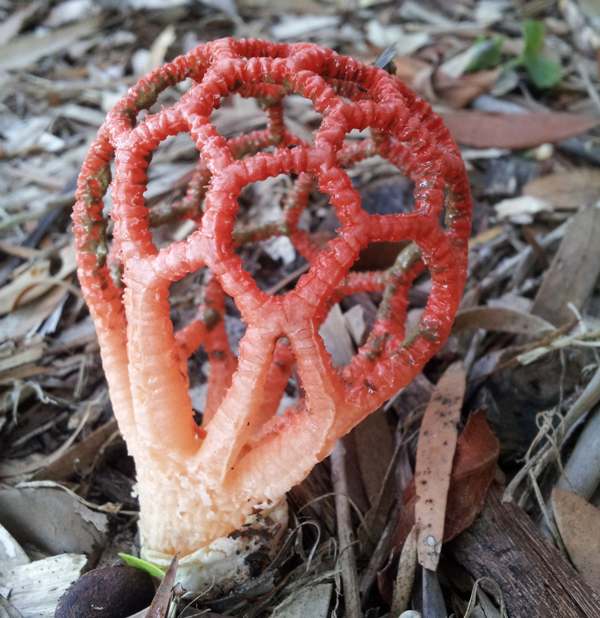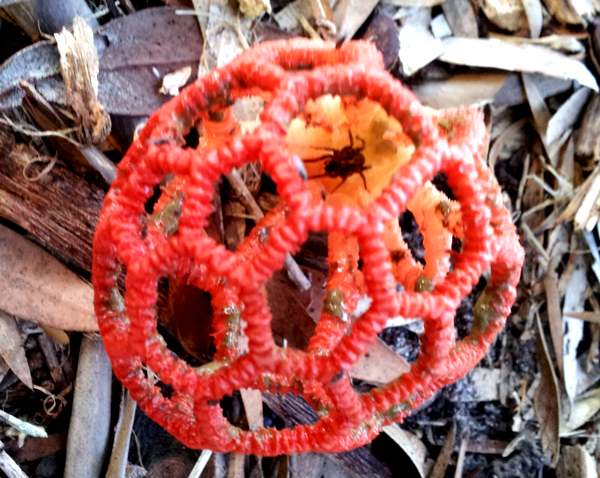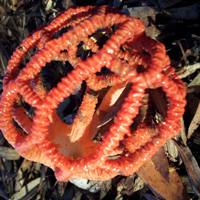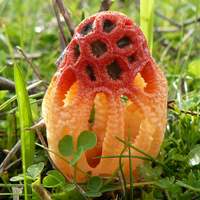Colus pusillus (Berk.) Reichert - Craypot Stinkhorn
Phylum: Basidiomycota - Class: Agaricomycetes - Order: Phallales - Family: Phallaceae
Distribution - Taxonomic History - Etymology - Identification - Reference Sources

Colus pusillus is remarkable and striking, to both visual and olfactory senses. It is just one of the many strange stinkhorns that produce smelly spore-laden gleba that attracts flies. The flies eat what they can of the gleba, but enough spore-laden slime sticks to their feet so that as they fly off and alight elsewhere the spores are distributed to potential new territory for this fungal species.
This process must work, because like the insects that serve as their spore-distribution couriers, the various cage-like fungi found throughout tropical and sub-tropical climes do not appear to be in any real danger of extinction.
The picture above shows a mature fruitbody growing in its typical habitat of rotting leaves (often eucalyptus).
There are several genera of cage-like fungi including Colus, Clathrus, Ileodictyon and Lysurus.
Distribution
Not found in Britain or elsewhere in Europe, the Craypot Stinkhorn seems to be restricted to Australia, where the specimens shown on this page were found by Patrea Andersen.

Taxonomic history
First described scientifically in 1845 by English mycologist Miles Joseph Berkeley, who established it basionym as Clathrus pusillus, the currently-accepted scientific name is Colus pusillus, after a 1940 publication in the Palestine Journal of Botany and Horticultural Science by the Polish-born Jewish biologist Professor Israel Reichert (1891 - 1975).
Synonyms of Colus pusillus include Clathrus pusillus Berk., Clathrella pusilla ( Berk.) E. Fisch., Colus muelleri E. Fisch., and Clathrus higginsii F.M. Bailey.
Etymology
The generic name Colus is Latin and means distaff - a fusiform tool used in spinning and the form of this fungus fruitbody when it is young. (In much the same vein, the gastropod Colus islandicus has a distaff-shaped shell.)
The specific epithet pusillus means small or insignificant.
Identification guide
 |
DescriptionInitially appearing as a half-buried whitish ball or 'egg' up to 2cm in diameter, the cage-like form of this fungus becomes visible once the outer membrane of the egg bursts. Fruitbodies erupt and then collapse in little more than 24 hours, and within two or three days all signs of the fruitbodies have usually disappeared. Typically 8cm across and 10cm tall when fully mature, with the cage section roughly spherical and comprising a narrow-limbed currugated lattice framework with typically eight dividing and rejoining branches, this fungus hasa very short pale stem above its torn whitish volva. The inside of the cage is coated with an olive-brown smelly gleba that attracts flies; the gleba sticks to the legs of the flies and is carried away to where a new Craypot Stinkhorn colony might result. |
SporesElongated ellipsoidal to cylindrical, smooth, 4.5-6 x 1.5-2µm. Spore printOlive-brown. |
|
Odour/taste |
Strong, unpleasant odour reminescent of rotting meat; taste not documented... at least, I can't find anyone owning up to having tried it!. |
Habitat & Ecological role |
Saprobic, in rotting leaf litter, often of eucalyptus |
Season |
These stinkhorns can appear at almost any time of year if the weather is sufficiently warm and wet. |
 |
Similar speciesLeft: Colus hirudinosus (syn. Clathrus hirudinosus) has an elongated fruitbody otherwise quite similar to that of Colus pusillus; it is found mainly in southern Europe, northern Africa and parts of Asia. (Picture courtesy of Penny Turner) Clathrus ruber, which occurs in Europe (including Britain) is of similar form but it has a less open cage structure formed without wrinkled surfaces. |
Reference Sources
Colus pusillus (Berk.) Reichert, Palest. J. Bot., R. Ser.: 190 (1940)
Dictionary of the Fungi; Paul M. Kirk, Paul F. Cannon, David W. Minter and J. A. Stalpers; CABI, 2008
Taxonomic history and synonym information on these pages is drawn from many sources but in particular from the British Mycological Society's GB Checklist of Fungi.
Acknowledgements
This page includes pictures kindly contributed by Patrea Andersen.
Fascinated by Fungi. Back by popular demand, Pat O'Reilly's best-selling 450-page hardback book is available now. The latest second edition was republished with a sparkling new cover design in September 2022 by Coch-y-Bonddu Books. Full details and copies are available from the publisher's online bookshop...

